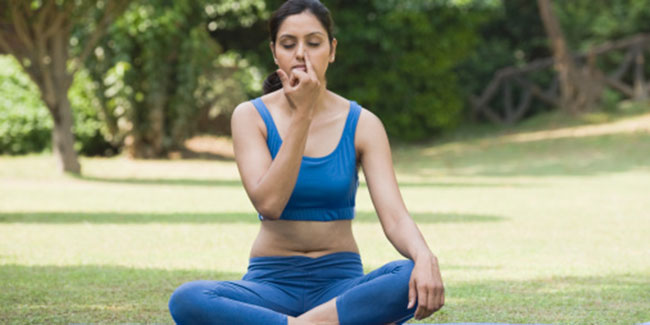
Diabetes is a metabolic kapha type of disorder in which diminished functioning of agni (digestive fire) leads to a tendency toward high blood sugar. Try pranayama for the diabetes cure.

Kapalabhati
Kapalabhati is a Sanskrit word where ‘Kapala’ means skull, and ‘bhati’ means "to shine." This dynamic purification exercise has noteworthy benefits like providing a bath of recently sanitised blood to the brain and clearance of nasal passages.
Table of Content:-
Method
- Think of kapalabhati as an abdominal exhalation exercise.
- Sit upright in a comfortable position and then inhale. Keep in mind not to move your chest and shoulders.
- Just exhale completely. Now you’ll feel some commotion in your diaphragmatic muscle. It should be noted how the first segment of the exhalation is completely natural and how forcing out more air will lead to a contraction in the abdominal muscles.
- Unless you feel you are beginning to use the abdominal muscles to complete the exhalation, continue this for few times.
- The exhalation in kapalabhati is petite, dominant, and absolute, and it takes the due amount of practice to become faultless.
- Set in motion by ascertaining a baseline of profound and levelled nasal breathing. Begin with an exhalation of contracting the face of abdomen muscles--from just below the ribs to the pelvis--strongly and swiftly, forcing the air out of the nostrils.
- Keeping in mind there is no other activity and no blockage of the nostrils, this shall conclude in the throwing out the air via nostrils.
- It is to be noted that while performing this asana only the abdomen moves and the rest of your body should be kept entirely still.
- Please note that each exhalation should be comfortably comprehensive.
- Without pausing, allow the abdomen to come back to its natural position. Do not inhale actively. This technique surely and slowly requires practice.
Words of caution
- Any pointed or unrelenting pain is a signal to stop.
- It is also advisable to consult your physician who understands breathing exercises before continuing this particular asana. Patients suffering from high blood pressure and coronary heart disease should not practice kapalabhati without consulting a health care provider.
- It is to be noted, that this asana should be practised only on empty stomach.
- If you feel dizzy or if you are unable to maintain a balanced rhythm or you experience any cramp in your stomach, stop immediately.
Ujjayi Breathing
Ujjayi, a pranayama that draws on sound and necessitates chest expansion, is a technique based on which you can practice different techniques that contravene some of the tenets of healthy breathing. Ujjayi introduces a determined tension, in contrast with diaphragmatic breathing, in which the throat is relaxed. An audible shuddering is a fundamental characteristic of the ujjayi breath, unlike in the diaphragmatic breathing which is silent.
Ujjayi is an amalgamation of two Sanskrit terms, ut, meaning "up," and jayi, meaning "victory." Ujjayi assists a practitioner in prevailing over derangement of the crucial force known as uddana, the upward-flowing pranayama.
Method
- The preliminary point for ujjayi is a comfortable, stable sitting posture.
- However, sit on the edge of a chair with your feet flat on the floor and your spine straight, if you are not comfortable in any of these postures. Your shoulders should not hunch nor should your back be rounded.
- Once you are seated with ease, take a few breaths to institute yourself flat and still with diaphragmatic breathing.
- The breath should be deeper than regular breaths as ujjavi necessitate inhalation beside the supplementary confrontation of a constricted glottis. Expanding the abdomen fully during inhalation and to contract it completely during exhalation is the simplest way to deepen the breaths.
- By expanding the sides and the back by holding a slight amount of tension in the abdomen – can be used as an alternative way to deepen your breath. This dampens the development of the stomach, which is unregulated in simple diaphragmatic breathing.
- This technique of deep breathing enlarges the entire lower rib cage gradually and consistently.
- Consequently, the total perimeter of the torso expands including the flanks, the back, and the front of the upper tummy. Certainly leading to some movement in the chest and will be hard to separate because the chest and the abdomen will be intensifying at the same time.
- While placing the middle fingers at the bottom edge of the ribs, judiciously place your palms on your sides, pointing toward each other, in order to experience this asana.
- The tips of your middle fingers should barely touch, at the end of an exhalation, while the ribs should be highly contracted.
- The tips of your fingers should pull apart, up to an inch, as the rib cage enlarges, during your inhalation period.
Advantages
Ujjayi as a practice can be inculcated in your daily routine- while waiting in a slow-moving line at the checkout counter or when you’re stuck in traffic or during any kind of tense moments. A few breaths can render you cool and calm. The sound is so low that even a person next to you may not notice it. Ujjayi proposes an opportunity to intensify your awareness and improves your ability to manage your mind, soul and energy levels. It sure deserves a try!
Image Source: Getty
How we keep this article up to date:
We work with experts and keep a close eye on the latest in health and wellness. Whenever there is a new research or helpful information, we update our articles with accurate and useful advice.
Current Version